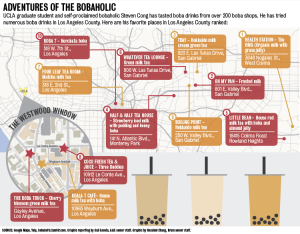Steven Cong was stumped when he was handed his first boba drink.
He and his friend looked at the plastic-sealed beverage with curiosity, wanting to taste the cold slushy drink and the soft tapioca pearls.
“Are we supposed to peel the seal?” Cong pondered. “Or should we just rip it off?”
The cashier looked at them with pity, he said, as she helped them stab their straws through the plastic cover. They complied, although they thought the stabbing was humorously violent, and took a sip.
For Cong, the rest was boba history.
Since high school, the UCLA graduate student in Asian American studies has tasted boba drinks from over 200 shops. He compiled a database called Bobahol1c to record and feature his critiques of the beverages.
To Cong, it’s more than a love affair with the refreshments. His love for boba, he said, is motivated by his interest in how it can facilitate identity and social interactions.
After his first time trying boba in high school, his sense of identity was heightened, he said. Boba drinks reassured his identity as an Asian American growing up in areas with a small Asian American population such as the North Bay and Puyallup, Wash.
“It’s one thing to form your identity within yourself,” Cong said. “It’s also helpful when you see yourself represented in other platforms externally.”
In high school, he would take a two-hour bus ride to Bobachine Bubble Tea in Seattle to buy his favorite drink.
“(Boba culture) was something I really wanted to grasp on to,” Cong said.
Cong said he loves boba for more reasons than its taste. His favorite aspect about the concoction is its dynamic and evolving nature.
“I think it’s something that challenges the idea that Asian Americans traditions are static,” Cong said.
In Cong’s current boba adventures, he has explored different boba trends in Washington, Illinois, China, and his favorites in Southern and Northern California.
The large Asian population in California contributed to the prominence of the boba fad today, said Jean-Paul deGuzman, a UCLA alumnus, author of a paper on boba and Asian American studies lecturer at California State University, Long Beach.
The boba scene in Los Angeles is unique, Cong said, in that it is dominated by trendy, independent boba shops such as AU79 Teahouse in San Gabriel. Northern California and China, on the other hand, are dominated by large Taiwanese brands such as CoCo Fresh Tea & Juice, he said.
Cong logs his boba trips in his personal database, which include critiques that rate drinks on a scale of one to 10. The main criterion in his rating system, he said, is whether the drink motivates him to go back.
His criteria is based on the complexity of flavor of a specific drink, Cong said. Sea salt drinks, which are his preferred boba beverages, should have a rich and creamy texture that is not overwhelming or thick. Milk tea drinks, like the Hokkaido Milk Cream Green Tea at TBay in San Gabriel, should have an appropriate balance of sweetness and a smooth texture.
“When I finish a cup (of milk tea), I don’t want to think, ‘Oh my god, I can’t eat after this’ or ‘I gotta run a mile,'” Cong said.
Cong said he rarely gives boba drinks below a score of five to support boba businesses. If the concoction is unique and tastes good, he will give it an eight or nine. He said he never gives a beverage a score of 10 instantly – Cong only gives drinks top marks after weeks or months of pondering.
In Westwood, Cong’s top-rated drink is CoCo Fresh Tea & Juice’s Three Buddies drink, because he thinks its house milk tea is perfectly sweet and its tapioca pearls are nicely chewy. To keep the tapioca pearls soft, Frances Bundalian, a third-year psychobiology student and CoCo employee, said CoCo keeps pearls for two hours maximum before throwing them away.
However, Cong said his boba tasting days are numbered because he wants to maintain his health. In general, boba drinks contain high levels of fats and carbohydrates due to its milk and tapioca pearls.
“At some point in time, I’d have had too much and my metabolism can’t handle (it). It can’t go on forever,” Cong said. “Health-wise, it’s not wise.”
Until then, Cong is planning to try the boba drinks of New York in an upcoming vacation.
Although Cong publicly critiques boba drinks, he said he is not trying to find the best boba in the world for anybody.
“Everybody has different tastes. One person’s taste will not be the same as another’s,” Cong said. “It’s okay to be subjective because I’m only trying to figure out what’s best for myself.”


Even the students just love drinking green tea.
He needs this app: https://play.google.com/store/apps/details?id=com.kritikalerror.findmepmt
Here’s a sortable, searchable database I created based on the data from Cong’s reviews: http://heyplayagee.github.io/bobahol1cDB